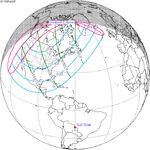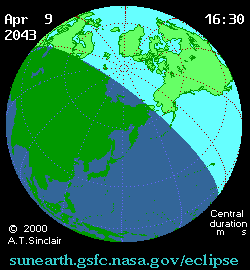Solar eclipse of April 9, 2043
| Solar eclipse of April 9, 2043 | |
|---|---|
UTC) | |
| Greatest eclipse | 18:57:49 |
| References | |
| Saros | 149 (22 of 71) |
| Catalog # (SE5000) | 9603 |
A total
It will be unusual in that while it is a total solar eclipse, it is not a central solar eclipse (when the gamma is 0.9972 or larger). A non-central eclipse is one where the center-line of totality does not intersect the surface of the Earth. Instead, the center line passes just above the Earth's surface. This rare type occurs when totality is only visible at sunset or sunrise in a polar region.
Visibility
It will be seen fully from Russia's
Settlements of total phase: Evensk, Omsukchan, Palana, Seymchan and Zyryanka.
Images
Related eclipses
Solar eclipses of 2040–2043
This eclipse is a member of a semester series. An eclipse in a semester series of solar eclipses repeats approximately every 177 days and 4 hours (a semester) at alternating nodes of the Moon's orbit.[1]
| Solar eclipse series sets from 2040 to 2043 | ||||
|---|---|---|---|---|
| Ascending node | Descending node | |||
| 119 | May 11, 2040 Partial |
124 | November 4, 2040 Annular | |
| 129 | April 30, 2041 Total |
134 | October 25, 2041 Annular | |
| 139 | April 20, 2042 Total |
144 | October 14, 2042 Annular | |
| 149 | April 9, 2043 Total (non-central) |
154 | October 3, 2043 Annular (non-central) | |
Saros 149
Solar saros 149, repeating every about 18 years and 11 days, contains 71 events. The series started with a partial solar eclipse on August 21, 1664. It has total eclipses from April 9, 2043, to October 2, 2331. The series ends at member 71 as a partial eclipse on September 28, 2926. The longest total eclipse will be on July 17, 2205, at 4 minutes and 10 seconds.[2]
| Series members 15–25 occur between 1901 and 2100: | ||
|---|---|---|
| 15 | 16 | 17 |
 January 23, 1917 |
 February 3, 1935 |
 February 14, 1953 |
| 18 | 19 | 20 |
 February 25, 1971 |
 March 7, 1989 |
 March 19, 2007 |
| 21 | 22 | 23 |
 March 29, 2025 |
 April 9, 2043 |
 April 20, 2061 |
| 24 | 25 | |
 May 1, 2079 |
 May 11, 2097 | |
Metonic series
The metonic series repeats eclipses every 19 years (6939.69 days), lasting about 5 cycles. Eclipses occur in nearly the same calendar date. In addition, the octon subseries repeats 1/5 of that or every 3.8 years (1387.94 days). All eclipses in this table occur at the Moon's ascending node.
| 21 eclipse events between June 21, 1982, and June 21, 2058 | ||||
|---|---|---|---|---|
| June 21 | April 8–9 | January 26 | November 13–14 | September 1–2 |
| 107 | 109 | 111 | 113 | 115 |
| June 21, 1963 | April 9, 1967 | January 26, 1971 | November 14, 1974 | September 2, 1978 |
| 117 | 119 | 121 | 123 | 125 |
 June 21, 1982 |
 April 9, 1986 |
 January 26, 1990 |
 November 13, 1993 |
 September 2, 1997 |
| 127 | 129 | 131 | 133 | 135 |
 June 21, 2001 |
 April 8, 2005 |
 January 26, 2009 |
 November 13, 2012 |
 September 1, 2016 |
| 137 | 139 | 141 | 143 | 145 |
 June 21, 2020 |
 April 8, 2024 |
 January 26, 2028 |
 November 14, 2031 |
 September 2, 2035 |
| 147 | 149 | 151 | 153 | 155 |
 June 21, 2039 |
 April 9, 2043 |
 January 26, 2047 |
 November 14, 2050 |
 September 2, 2054 |
| 157 | ||||
 June 21, 2058 | ||||
References
- ^ van Gent, R.H. "Solar- and Lunar-Eclipse Predictions from Antiquity to the Present". A Catalogue of Eclipse Cycles. Utrecht University. Retrieved 6 October 2018.
- ^ Saros Series Catalog of Solar Eclipses NASA Eclipse Web Site.

